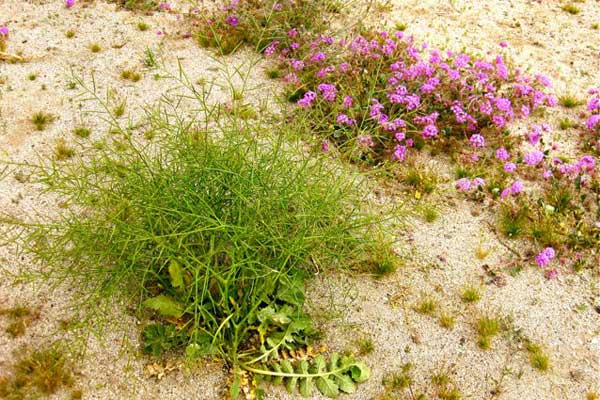
Tubb Canyon Desert Conservancy
Sahara Mustard: FAQs
- What is Sahara Mustard?
- Why is Sahara Mustard a problem? Isn't it just another desert plant?
- Does Sahara Mustard really come from the Sahara Desert in Africa? Does it have any other names?
- What does Sahara Mustard look like, including its seeds?
- Why don't I see Sahara Mustard all the time? I went out into the desert, but can't see any evidence that Sahara Mustard is "taking over."
- How does Sahara Mustard spread so fast? What distributes its seeds so far across the desert?
- What will happen if Sahara Mustard is not controlled?
- How, where & when did Sahara Mustard get into North American deserts?
- Isn't there an herbicide or other agricultural chemical that can destroy Sahara Mustard?
- Don't rabbits, deer & bighorn sheep eat Sahara Mustard?
- Can't domestic goats be used to get rid of Sahara Mustard?
- Do wild birds eat Sahara Mustard or its seeds?
- Are there no natural enemies of Sahara Mustard?
- Why do ants carry Sahara Mustard seeds back to their colonies underground?
- Fighting Sahara Mustard seems hopeless... What can be done to save the desert?
- I'd like to help stop Sahara Mustard, but I cannot physically pull mustard myself... and I don't have a lot of money to donate for mustard removal teams or programs. Is there anything else I can do to help?
- How can I pull Sahara Mustard and dispose of it properly?
- If I pull and bag Sahara Mustard where can I dispose of the bags so no seeds escape into an open land-fill?
- Is it true that Sahara Mustard is edible?
What is Sahara Mustard?
Sahara Mustard is a fast-growing, tough, desert-adapted foreign weed which is taking over much of the Sonoran and Mojave Deserts across the U. S. Southwest. It is a "winter annual," meaning that the plant germinates during winter rains, grows to maturity quickly, sets thousands of seed for the next generation, then the parent plant dies, often breaking off in high wind to become a dry "tumbling weed" that spreads its seeds wherever it is blown.
Why is Sahara Mustard a problem? Isn't it just another desert plant?
Sahara Mustard is a foreign plant that kills native plants in both the Mojave and Sonoran Deserts of North America. It spreads quickly and, if unchecked, will rapidly take over native habitat until nothing but mustard grows in the desert. Wildlife will die because all of the plants upon which desert animals depend will be gone. Insects, frogs, lizards and snakes, rodents, rabbits, birds, deer, bighorn sheep and all the predators that eat them, such as grey foxes, coyotes, skunks, bobcats, cougars, falcons and hawks... will all disappear.
Does Sahara Mustard really come from the Sahara Desert in Africa? Does it have any other names?
Sahara Mustard (Brassica tournefortii) is a common native mustard in the semi-arid and arid deserts of Northern Africa, including regions of the Sahara Desert; however, it is also found in parts of the Middle East, Pakistan and in drier Mediterranean regions of Southern Europe, where it may be a recent "colonist."
Sahara Mustard is known by several common names, including:
- Asian Mustard
- Moroccan Mustard
- Desert Mustard
- Mediterranean Mustard
- Mediterranean Turnip
- Wild Turnip Weed
- Prickly Turnip
In Spanish, Sahara Mustard is known as Mostaza del Sahara or Mostaza del Desierto.
What does Sahara Mustard look like, including its seeds?
Sahara Mustard is a bright green plant with a basal rosette of large, dandelion-like leaves. Above the large basal leaves grows a canopy comprised of numerous, nearly leafless thin stems that sprout branches with tiny pale yellow flowers on the their ends. These flowers are self-pollinating, so each flower will develop a long, thin green bean-like pod full of tiny poppy-like red seeds. Sahara Mustard plants mature enough to produce seed pods can be small (6 inches high) to large (2 feet wide and up to 4 feet tall) depending upon their age and growing conditions. Masses of bright green Sahara Mustard can have the appearance of a shrub or hedge when seen from a distance.

Sahara Mustard (Brassica tournefortii) growing next to desert sand verbena (Abronia villosa) with purple blooms in Borrego Springs, California.
For further information, see Identifying Sahara Mustard and
the Sahara Mustard Life Cycle Slideshow.
Why don't I see Sahara Mustard all the time? I went out into the desert, but can't see any evidence that Sahara Mustard is "taking over."
Large, green Sahara Mustard plants can only be seen during the desert growing season after winter and/or spring rains. Sahara Mustard is a "winter annual." After going to seed, the parent plant withers and dies. During hot summer months, before sufficient rain enables Sahara Mustard seeds left in the soil to germinate anew, adult Sahara Mustard plants die and "disappear" from view.
If one knows what to look for, though, evidence of Sahara Mustard infestation can be seen year-round in the form of dead, white "sticks" left standing where the parent plant once grew (see photo below). Those 8 to 12 inch (20 to 30.5 centimeter) white sticks are all that remain of the main stem of a Sahara Mustard plant after its more fragile canopy of branches has died and broken off. Large mustard plants can dry into white "tumble weeds" of a few dead branches that blow around in the wind and can be seen trapped among cacti, creosote bushes, and other vegetation.
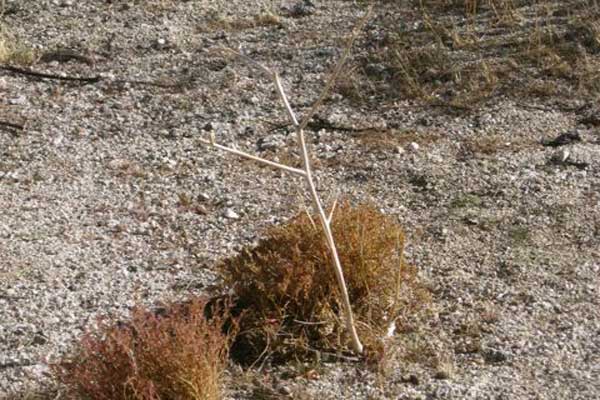
The dead, white stick in the center of the above photo is all that remains of Sahara Mustard after it goes to seed and the parent plant dies. These "white sticks" are evidence that an abundance of dormant mustard seeds are in the ground at that location, awaiting the next rainy season to germinate.
Though Sahara Mustard cannot be seen as a large, green plant for much of the year, do not be deceived! Sahara Mustard seeds in the ground will germinate quickly after rain and continue to takeover native wildflower fields, invading deeper into the desert with each passing growing season.
How does Sahara Mustard spread so fast? What distributes its seeds so far across the desert?
Sahara Mustard evolved in a very harsh desert environment. It's survival strategies include fast germination and growth, so that it can out-compete other seedlings and grow large enough to overshadow other plants, depriving them of needed sunlight. Sahara Mustard also grows a long, carrot-like taproot that commandeers water for its own growth while desiccating nearby plants. There is also some evidence that Sahara Mustard exudes chemicals into the soil which inhibit growth in other plant species, including tough desert shrubs such as creosote and some cacti. Sahara Mustard matures quickly and is capable of producing seed pods under adverse conditions, such as nutrient-poor soil or direct sun and wind.
Sahara Mustard seed pods produce thousands of tiny, round red seeds. Each seed has a sticky, mucilaginous surface that readily "hitches a ride" on animal fur... or a desert visitor's shoes, clothing, and vehicle tires. Eventually the seeds fall off in a new location, thereby pioneering a new infestation site. Some mustard plants at the end of their annual life cycle also break off at the main stem in wind and become tumbling weeds that throw seeds into new locations as the plant is blown around.
With no major natural enemies in our deserts, this foreign weed's numerous survival traits make a formidable invader capable of killing native desert vegetation and replacing it with a Sahara Mustard wasteland devoid of wildflowers, butterflies, birds and other wildlife.
What will happen if Sahara Mustard is not controlled?
Sahara Mustard threatens to bring a real "Silent Spring" to the Anza-Borrego Desert and other deserts of the Southwest. Sahara Mustard quickly multiplies to overshadow, poison, and rob water from the wildflower fields and blooming cacti that bring so many visitors from around the world to see the. Eventually, Sahara Mustard can kill even tough creosote, cholla and barrel cacti, literally taking over the desert and turning it into a mustard wasteland devoid of the biodiversity needed to sustain desert wildlife, from butterflies to lizards, pocket mice to owls, hummingbirds to bobcats, roadrunners, quail, and all the others. Without the wildflowers, shrubs and cacti in our landscape, there will be no bird songs, no chorus of frogs on spring nights... and no human visitors... in a decimated ecosystem.
How, where & when did Sahara Mustard get into North American deserts?
Sahara Mustard seeds probably "hitchhiked" to the Desert Southwest as a contaminant in a variety of crop seed shipments or perhaps arrived on date palm seedlings. Sahara Mustard may have been present in the Coachella Valley as long ago as 1927. In 1957 Sahara Mustard was identified along Mexico Highway 2 near the U.S. border, growing along the road where Mexico Highway 2 becomes U.S. Route 95 near Yuma.
By the 1970s Sahara Mustard had spread into low elevation, arid deserts across Arizona and southeastern California in the U.S. It was also identified in Baja California and Sonora, Mexico. At that time, though, Sahara Mustard was confined to dense patches in sandy washes and disturbed soils, such as roadsides, in off-road vehicle recreational areas, and in sand quarries or "borrow pits." Sahara Mustard had not yet invaded undisturbed, natural desert habitat, nor did it appear to be taking over entire regions at a rapid rate.
Around 1997 a devastating change seems to have occurred. What is now thought to be a pernicious new Sahara Mustard strain appeared. "Ground Zero" for this more aggressive form may have been in Riverside County near the junction of California State Routes 177 (Desert Center Rice Road) and 62 (Twentynine Palms Highway) on the eastern edge of Joshua Tree National Park, California. This adaptable variant of Sahara Mustard exploded beyond isolated sandy washes and disturbed areas and rapidly began invading deep into natural desert vegetation. It even began appearing at higher elevations and in rockier terrain than prior forms of Sahara Mustard. According to Craig Dremann, owner of The Reveg Edge / Ecoseeds Environmental Services, who has surveyed Sahara Mustard infestations in the field, this "new" type of Sahara Mustard could be identified not only by its greater invasive habits, but also by its unique, brick red color seeds that are unlike any of the Sahara Mustard seeds in USDA collections. This is the Sahara Mustard which now threatens both the great Mojave and Sonoran Deserts of the U.S. and northern Mexico.
It is now believed that the practice of using desert sand and gravel from "borrow pits" for construction fill has been responsible for transporting highly invasive Sahara Mustard seeds far distances. Wherever mustard seeds dropped off of trucks and tires, or were dumped with fill sand and dirt, there Sahara Mustard has germinated and quickly established itself. Urban and suburban areas around Tucson, Arizona, for example, have been highly colonized by Sahara Mustard, which has radiated quickly from those locations to take over adjacent wild desert. Off-road vehicles are another major "carrier" of Sahara Mustard into wild desert habitat and popular recreational destinations.
Budget-strapped government agencies, land managers, and academics sounded the alarm about Sahara Mustard by 2003, but failed to take coordinated, extensive and effective action against growing Sahara Mustard infestations. Part of their complacency may have resulted from the fact that Sahara Mustard is an annual that "disappears" and can remain dormant in a seed bank during years of extreme cold or drought. In addition, in spite of research data and warnings from academia, there has been little money allocated for comprehensive control of this weed, which has allowed Sahara Mustard to become a growing ecological disaster across the entire desert Southwest.
The Sahara Mustard invasion became noticeable in the Anza-Borrego Desert around 2005, with the weed rapidly expanding its range since that time into Borrego Valley and the surrounding state park. Mustard seed-contaminated construction fill and date seedlings, along with seeds transported by tourists on their vehicles and camping equipment, and off-road vehicles have "inoculated" popular desert destinations and continue to spread Sahara Mustard. From both paved and unpaved roads, mustard radiates out to overwhelm wildflower fields and the open desert.
To date, Sahara Mustard has moved into the Sonoran and Mojave Deserts in southeastern California; southern Nevada (at the confluence of the Great Basin, Mojave and Sonoran Deserts); Baja California and Sonora, Mexico; eastward into Arizona with an increasing number of plants being found in extreme southwestern New Mexico and parts of southern Utah.
The Federal Interagency Committee for the Management of Noxious & Exotic Weeds (FECMNEW) conducted a recent inventory of land management agencies in California and Arizona, the two states hit most severely by Sahara Mustard infestation. According to their report, Sahara Mustard has invaded numerous parklands, including (in alphabetical order):
- Anza-Borrego Desert State Park, California
- Death Valley National Park, California
- Grand Canyon National Park, Arizona
- Joshua Tree National Park, California
- Lake Mead National Recreation Area, Arizona & Nevada
- Mohawk Dunes, Barry Goldwater Air Force Range (Luke Air Force Base), Arizona
- Mojave National Preserve, California
- Organ Pipe National Monument, Arizona
Isn't there an herbicide or other agricultural chemical that can destroy Sahara Mustard?
Yes. There are many herbicides that can kill Sahara Mustard. Unfortunately, those chemicals are even more toxic to native desert plants than to the mustard. The "cure" turns out to be more fatal than the "disease" to fragile wildflowers and other native vegetation, including barrel cacti and most herbaceous shrubs. There is ongoing research to find a targeted herbicide that can be applied at just the right time to kill germinating Sahara Mustard, but not harm annual wildflowers or other plants. Thus far, research in this area has been very disappointing. A chemical that kills only Sahara Mustard and does no harm to other plants would be a panacea, but no such treatment yet exists.
Don't rabbits, deer & bighorn sheep eat Sahara Mustard?
There is little data regarding what animal species consume Sahara Mustard. It has been observed that rabbits will occasionally nibble on young Sahara Mustard seedlings; however, it is clear that rabbits and other herbivorous foragers eat little, if any, mature Sahara Mustard. Deer and bighorn sheep occupy higher elevation habitats where Sahara Mustard has begun to invade; however, it does not appear that the mustard is consumed at all by these large browsing species. Like many mustards, Sahara Mustard is high in oxalic acid and may be too bitter and unpalatable to most wildlife.
Can't domestic goats be used to get rid of Sahara Mustard?
Goats are not the answer to eliminating Sahara Mustard. While they may be able to survive by eating some mustard, goats greatly prefer grazing on more palatable native plants first. Goats and other livestock would cause serious damage to desert vegetation and stable soil surfaces long before they would have any beneficial impact on Sahara Mustard growth. Some seeds passing through a goat's digestive tract may remain viable, transporting some seeds to wherever a goat goes next.
Do wild birds eat Sahara Mustard or its seeds?
Little is known about whether or not wild birds consume Sahara Mustard, including its red seeds. It does not appear that Sahara Mustard's round red seeds are palatable to local seed-eating bird species, such as sparrows, towhees, finches, warblers, doves, and quail. Even if birds occasionally eat Sahara Mustard seeds, their consumption does not appear to have a significant effect on reducing mustard reproduction. It is known that areas completely taken over by Sahara Mustard lose resident and migratory birds. Where nothing besides Sahara Mustard grows, birds and other wildlife cannot thrive and biodiversity is lost.
Are there no natural enemies of Sahara Mustard?
As a foreign plant, Sahara Mustard has been removed from the ecosystem in which it evolved. Where mustard originated in Africa and the Middle East, there are undoubtedly insects, larger animals, and competitive plants that keep Sahara Mustard in check; however, those species do not exist naturally in the Southwestern United States where Sahara Mustard is not native.
If there is a "natural enemy" of Sahara Mustard it is a healthy, balanced desert ecosystem. Just the way a stressed, malnourished or unhealthy person is more susceptible to catching an infection, desert habitat that has been grazed (even a century before), damaged by off-road vehicles, excavated, or traversed by roads, is far more vulnerable to Sahara Mustard takeover.
There are native plants that seem to exclude or resist Sahara Mustard incursion, such as species of phacelia (wildflowers commonly known as "fiddleneck"). Phacelia campanularia (Desert Bluebell), P. distans (Wild Heliotrope), P. crenulata (Notch-leaf & Cleft-leaf Phacelia), and P. minor (Canterbury Bells) are all common in healthy Anza-Borrego Desert habitats. More study is required to identify natural assemblages of native plants, including annuals, perennials, shrubs, trees, succulents and cacti, that are most resistant to Sahara Mustard invasion.
Interestingly, a non-native, invasive crop pest that consumes mustard (Brassica) species, including Sahara Mustard, arrived in Los Angeles County back in 2008.* The Bagrada Bug, also known as the Painted Bug, (Bagrada hilaris) is a stink bug native to eastern and southern Africa, southeastern Asia, and southern Europe (primarily Malta and Italy). Sahara Mustard is native to many of these same regions. The foreign Bagrada Bug has invaded low deserts and Coachella Valley crops and appears to be rapidly spreading across California, parts of Nevada, Arizona and New Mexico. Thus far, Bagrada Bugs are not apparent in the Anza-Borrego Desert, but that situation may change soon.
Bagrada Bugs are not deterred by desert heat and aridity. Birds and other wildlife seem to find Bagrada Bugs distasteful. It is not clear what native desert plants this pest species might favor. Introduced Black Mustard (Brassica nigra) that is common in California foothills, along with Sahara Mustard (Brassica tournefortii), may become significant targets, as well as potential reservoirs, for this highly invasive stink bug that damages cruciferous vegetables (broccoli, cauliflower, kale, cabbage, etc.), cotton, strawberries and other important food crops.
Though Bagrada Bugs will consume Sahara Mustard, because these bugs also threaten numerous food crops, they are not a desirable biocontrol for mustard. It remains to be seen if a Bagrada Bug invasion into desert ecosystems will have a significant impact on the spread of Sahara Mustard across the Southwest.
For more information about Bagrada Bugs and a slideshow of photos, visit the University of California at Riverside's Center for Invasive Species Research Bagrada Bug page.
Note that the immature nymphs of the Bagrada Bug are round and bright red (circled in the photo). When seen from a distance these nymphs can be mistaken for beneficial ladybugs.
* “Bagrada Bug,” Richard W. Hoenisch; UC Davis, Western Plant Diagnostic Network, Mar 2012
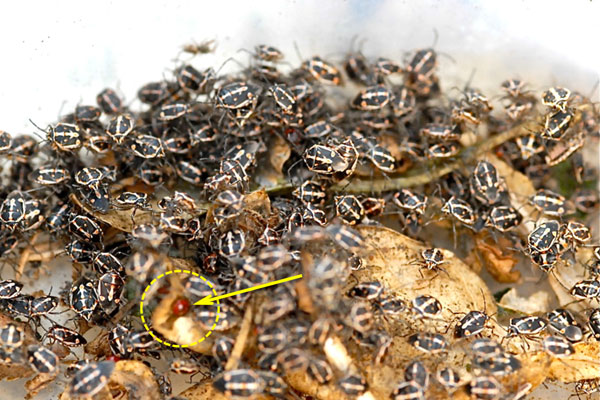
(Photo courtesy of Steven R. Kutcher, taken in the foothills of Arcadia, CA, 2012, where Bagrada Bugs have attacked Black Mustard)
Why do ants carry Sahara Mustard seeds back to their colonies underground?
It has been observed that native ants are highly attracted to Sahara Mustard seeds. When an ant encounters a red mustard seed, it will often pick the seed up and carry it back to its underground colony. It is not clear why ants do this. They may be consuming some portion of the seeds or destroying collected seeds by "farming" fungi on them underground. The fungi cultivated on seeds and other organic detritus by ants is, in turn, harvested and eaten by the ants... If this is the case, then native ants may help remove thousands of mustard seeds that might otherwise germinate.
More ominously, Sahara Mustard seeds may exude an ant attractant that encourages ants to carry the seeds underground where they are more likely to germinate. Some plant species disperse their seeds by offering ants an attractive, edible coating or part on their seeds. This is known as myrmecochory. Ants will carry seeds underground, consume the tasty coating or part, leaving the seed viable in a nutrient rich, safe location where it can germinate. Sahara Mustard seeds do not appear to have any "ant candy" attached to their structure, but this does not mean that mustards do not entice ants in some way to help them sew their seeds underground.
Further study of ant interactions with mustard seeds is needed to determine whether ants are natural enemies.... or inadvertent allies... of invading Sahara Mustard.
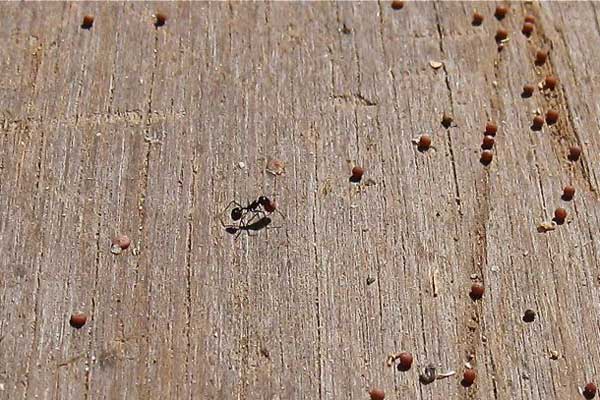
An ant carrying a red Sahara Mustard seed on a board surrounded by red seeds.
Fighting Sahara Mustard seems hopeless... What can be done to save the desert?
While the destruction of wildflower displays and native desert ecosystems is growing more imminent with every season Sahara Mustard multiplies and spreads, it is not yet too late to save the desert. Hundreds of acres in the Anza-Borrego Desert near Tubb Canyon have been cleared of Sahara Mustard. What is required is dedicated effort on the part of all those who care about the desert to hand-pull Sahara Mustard plants before they go to seed. Every mustard that is pulled and destroyed is one more plant that will not produce thousands of seeds. While the task seems overwhelming, it is not difficult. If everyone gets involved to clear a patch of desert land; if we all support teams of volunteers and workers to clear land of mustard, the desert can be reclaimed one wildflower patch and one acre at a time.
There are no government agencies, universities, nor nonprofit conservation organizations who can single-handedly stop Sahara Mustard from destroying the desert. Only by all of us getting involved and working together... to hand-remove mustard now, to study the problem and seek innovative methods of controlling Sahara Mustard in the future, and by restoring healthy desert habitat... only then will we be successful in protecting our vulnerable, beautiful deserts.
Drop by single drop are powerful rivers formed! Each of us as an individual matters greatly in the fight against Sahara Mustard, whether by pulling a mustard plant from beside the road, clearing all the mustard from a favorite patch of wildflowers... Or by making a small donation, educating others and/or writing a letter of concern.
For further information, see Identifying Sahara Mustard and No Mustard Left Behind. Please explore Ways to Help and Donate to TCDC! Become a Desert Guardian and participate in the easy to use TCDC Mustard Map App.
I'd like to help stop Sahara Mustard, but I cannot physically pull mustard myself... and I don't have a lot of money to donate for mustard removal teams or programs. Is there anything else I can do to help?
Yes! There are many ways to help eradicate Sahara Mustard that do not involve physical labor or contributions of money. Volunteers are needed with a variety of skills and expertise.
Everyone can greatly assist efforts to eliminate Sahara Mustard simply by bringing this ecological disaster to the attention of family, friends, news media, and local officials. The more residents and desert visitors request action to stop Sahara Mustard, the more likely it becomes that reporters, organizations and government agencies will pay attention and allocate funds for eradication programs and needed research.
Please visit Ways to Help or contact TCDC. We will be happy to explore ways you can become involved in saving the desert that match your abilities, available time and resources!
How can I pull Sahara Mustard and dispose of it properly?
Pulling Sahara Mustard is easy, if repetitive, physical labor. Once the mustard plant has been identified, grasp it at the base of its main stem with a gloved hand (mustard stems are covered with tiny hairs that can irritate the skin of some people). Pull steadily on the mustard's stem until the entire plant is pulled out of the ground by its pale, carrot-like tap root. Turn the mustard upside down and stuff it into a sturdy trash bag. Be particularly careful if there are nearly mature seed pods on the plant to get the entire plant, intact, into the trash bag. Keep adding mustard plants until the bag is full, then tie the top of the bag closed with a tie wire or other secure means.
For further information, see Identifying Sahara Mustard and No Mustard Left Behind.
If I pull and bag Sahara Mustard where can I dispose of the bags so no seeds escape into an open land-fill?
Always seal trash bags containing Sahara Mustard securely with twisty wire or string or adhesive tabs. Do not rely only on draw-string pull ties which may leave a small opening where seeds can fall out or that might come undone, opening a bag in transport or when knocked over by wind. It is important to keep plants with seed pods and seeds completely contained.
If only a few bags of mustard have been pulled around a desert home or business, it should be fine to dispose of them via regular trash pick-up. Large quantities of Sahara Mustard pulled in the Anza-Borrego Desert and securely bagged may be taken to the Anza-Borrego Desert State Park Headquarters near the park Visitor Center for disposal in dumpsters signed for Sahara Mustard. Do not transport loose bundles of Sahara Mustard to any disposal site! Always place mustard plants in secure, well-sealed trash bags. Patch any holes in bags where seeds might escape with shipping or duct tape (not scotch or masking tape). For bags that have large holes or tears, carefully place the damaged bag in another bag, then tie the doubled bag closed before disposal.
Is it true that Sahara Mustard is edible?
Like spinach, chard, parsley, sorrel, and beet greens, Sahara Mustard leaves are high in oxalic acid, which imparts a sharp, bitter taste. Rhubarb leaves are so high in oxalic acid that they are toxic when consumed in large quantity. Nevertheless, according to the Global Invasive Species Database excerpted below, cooked Sahara Mustard greens are edible. *Please note: None of us at TCDC have actually eaten Sahara Mustard; we are only citing reports from others whom we do not know personally.
The Plants For A Future Database (1997) states that the leaves of Brassica tournefortii can be used to create various oils. The authors state that the leaves and young shoots can be cooked, and edible oil can be obtained from the seed. Dr. Khaled O. Abukhabta (pers. com. 2005) reports from Libya that it is widely used as food, mixed with kuskus (couscous) and some other spices to give it a very good flavour. He adds that in addition to it's mild laxative effect (due to a high content of beneficial fibers), it contains 3-methylsulfinylpropyl glucosinolate, which reduces the risk of cancer of the lung, stomach, colon and rectum, with a possible reduction in endometrial and ovarian cancer and a decrease in total cancer incidence.
No one seems likely to publish a "Sahara Mustard Cookbook" anytime soon! If someone has eaten Sahara Mustard and can recommend a recipe, TCDC would like to hear from you!
